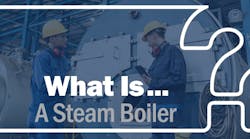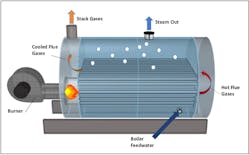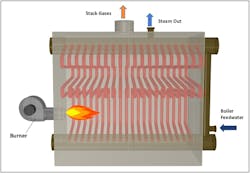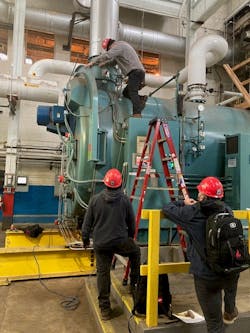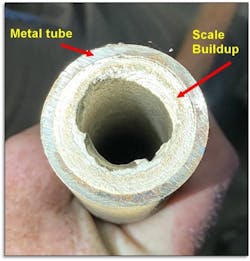Boilers are pressure vessels whose primary function is to produce steam (and hot water) for a variety of applications.
An energy source must be provided to a boiler to produce steam. In the commercial-industrial boiler world, this energy source often comes in the form of natural gas, propane, fuel oil, or electricity. A variety of renewable fuels such as biogas, biodiesel, other waste streams, and even solar are now coming on the scene with concerns over climate change and environmental sustainability.
This article will review steam boiler types, applications, maintenance, efficiency, and safety.
What are steam boiler types?
There are two general classifications of steam boilers, namely firetube boilers and watertube boilers. Each have their own advantages and limitations, and often one type is more suitable in a given application over the other.
Firetube Boilers. A firetube boiler consists of a boiler shell with a furnace section, a tube bank or banks, and a burner to produce the required heat.
Firetube boilers (see Figure 1) are much as their label describes; the fire and flue gases are contained within the boiler furnace and tubes. Water surrounding the furnace and tubes is converted into steam at various pressures and temperatures dictated by the boiler design, the controls, and application needs.
The fire produced by the burner is contained within the furnace or first pass of the boiler. Hot gases exit the furnace and reverse flow back toward the burner end through tubes, noted as the second pass. Throughout this process, heat is transferred from the hot gases to the surrounding fluid through the furnace and tube walls. Some boilers incorporate multiple tube bank passes, such as 3-pass and 4-pass boilers.
Depending on boiler design and operating steam pressure, exiting stack gases from the boiler typically range between 250 ºF and 600 ºF. Excess air for combustion is provided to ensure clean combustion and low emissions. In general, the lower the stack gas temperature and excess air requirements, the higher the resulting combustion efficiency.
Watertube Boilers. Watertube boilers (see Figure 2) are again much as their label describes; the water to be converted to steam is housed within the tubes and lower “mud” drum, with the upper steam drum housing bother water and steam. Similar to firetube boilers, fuel and air are mixed at the burner and combusted to produce a fire and hot gases. These hot gases surround the boiler tubes and drums containing water, subsequently transferring their heat to the water. Once again, excess air is provided to ensure clean and stable combustion.
Watertube boilers are often used in place of firetube boilers to produce larger steam quantities and higher operating steam pressures – even exceeding 300,000 pounds per hour and 1,000 psi in pressure. These larger sizes and pressures can adversely affect material thickness and overall footprint, prohibiting the use of firetube design boilers. Watertube type boiler designs have, however, become increasingly common among smaller sized units.
There are additional categories of boilers, such as cast iron, coil type, and others. These boiler types are generally smaller in size/capacity, and often found in residential homes, apartments, and small commercial buildings producing lower pressure steam for space heating use.
What are common boiler applications?
Steam boilers serve a variety of purposes in the residential, commercial, and industrial marketplace. Steam boilers are used for:
- Space and comfort heating of buildings and occupied spaces
- Food preparation
- Pharmaceutical, paper and pulp, cardboard manufacturing
- Medical needs, sterilization
- Military/governmental, and many other applications
Choosing the right boiler for your needs goes well beyond the scope of this article. However, key considerations in this decision-making process include how much steam is needed, and at what pressure(s). A boiler manufacturer, an authorized representative, or a consultant in this industry can often help answer these questions.
In confining this discussion to non-residential but commercial-industrial steam boilers, steam uses vary widely. As mentioned previously, small to mid-size units are often used to provide space heat for apartments and factories. Larger size units serve a great number of functions in the food, transportation, health/medical and pharmaceutical, and industrial process marketplaces. Whatever the application may be, the following factors are paramount to all of them:
- High operational efficiency
- Periodic maintenance scheduling and reporting
- Optimizing boiler uptime
- Proper water chemistry and water quality
- Securing a trusted and authorized service provider
What is good boiler maintenance?
A well operating and reliable boiler requires scheduled maintenance performed by qualified in-house personnel and/or boiler service agency (see Figure 3). Proper boiler maintenance encompasses both fire-side and water-side consideration.
Sound water-side maintenance begins with good feedwater quality to prevent corrosion and scale buildup on surfaces. There are recommended water quality values which can be provided by a water quality expert that addresses suspended and total dissolved solids (TDS) levels, dissolved oxygen, hardness, pH, alkalinity, and others. Routine boiler “blowdown” is normally required to maintain acceptable solids levels of boiler water within certain specified limits.
Boilers also require periodic fire-side inspection and maintenance to ensure boiler surfaces are kept clean, free from soot and scale, and identification of possible leakage. These inspections are typically performed semi-annually or on an annual basis. Scale buildup, shown in Figure 4, can lead to poor heat transfer and lower efficiencies. Even 1/16” of scale can account for 4% to 6% of total fuel use.
Boiler safety devicies, pumps, boiler controls, and other boiler equipment also require periodic inspection and maintenance where and when needed. Other boiler system devices such as steam traps can be a source of significant steam loss and inefficiency. Therefore, system devices such as steam traps should be inspected regularly.
What is boiler efficiency?
Boiler efficiency is a broad term used in the industry that is often misrepresented and misunderstood. Are we speaking of thermal efficiency? Combustion efficiency? Input-output efficiency? Stack loss efficiency? Are boiler jacket heat losses included?
Each term has its own definition and meaning. From the owner-operator’s point of view, a well-tuned, maintained, and operating boiler can yield thousands of dollars in operating expense annually.
Simply stated, whatever fuel energy delivered to the boiler that doesn’t produce usable steam represents a source of inefficiency. Maximizing boiler efficiency entails keeping stack temperatures low, boiler surfaces clean, excess-air levels for combustion low, reducing boiler cycling, and minimizing draft losses will provide optimal boiler performance. A general “rule-of-thumb” regarding excess air for combustion is that for every additional one percent of oxygen in the stack, roughly one-half percentage point of efficiency is lost. And for every additional 40 ºF in stack temperature, roughly one percentage point of efficiency is lost.
Accordingly, it is important to secure an experience and qualified boiler service agent or company to periodically inspect and maintain the boiler operating at peak efficiencies.
What is boiler safety?
A boiler explosion can be devastating to both human life and property. Considering that a boiler is a vessel under pressure and that the water contained will expand nearly 1,700 times within a fraction of a second if a boiler ruptures, it is imperative that strict safety guidelines and procedures are followed in the design, manufacture, installation, and operation of a boiler.
To prevent such occurrences, boiler and burner manufacturers adhere to strict design and safety codes and standards. Institutions such as the American Society of Mechanical Engineers (ASME), the National Fire Protection Association (NFPA), the American National Standards Institute (ANSI), the American Boiler Manufacturers Association (ABMA), Underwriters Laboratories (UL), the National Board of Boiler and Pressure Vessel Inspectors, insurance carriers, as well as state and local agencies provide the guidelines, codes, and standards by which boilers are built, installed, and operated.
When it comes to boilers, there are no shortcuts to safety. A well-tuned and maintained boiler and boiler system can provide many years of safe and money-saving service.
